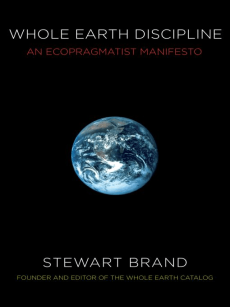Stewart Brand, author of Whole Earth Discipline, is described on the book cover as an icon of the environmental movement. He actually isn’t and doesn’t want to be. Brand (who, in full disclosure, is a friend) has always been much more of an iconoclast than an icon.
In Whole Earth Discipline, he combines his deep concern for the environment, his pugnacious search for windmills to tilt at, and his technological optimism to produce an intriguing, confounding, utterly Brand-type book. By that, I mean a full-throated assault on conventional wisdom, laced with enough ironic riffs and personal confessions of his own past errors to disarm most critics.
Brand came to public attention 41 years ago by publishing the wildly successful Whole Earth Catalog, a practical guide for back-to-the-land refugees from suburbia. The catalog questioned virtually every attribute of 1960s middle-class suburban America and offered a telephone directory-sized, annotated compilation of equipment for rural self-reliance. Ultimately, the back-to-the-land movement proved to be vanishingly small, over-fond of drugs, and stuck in a historical cul-de-sac.
In Whole Earth Discipline, Brand examines and embraces the scientific basis of some of the principal problems that scare the hell out of environmentalists. Indeed, his bottom line on global warming is among the bleakest I’ve ever read, and it’s probably correct. The book questions assumptions that most modern environmentalists take for granted (such as that a sustainable future will rely mostly on renewable energy sources or that sustainable diets will depend on organic crops) and proposes solutions that make most environmentalists gasp (such as nuclear power, genetically modified foods, and urbanization as a complete solution to population growth).
What makes this book different from the embarrassing essays of faux environmentalists like Patrick Moore and Bjorn Lomborg (who come to conclusions similar to Brand’s) is that Brand’s environmental values are long-standing and sincere, and he doesn’t slant his ideas to boost his speaker fees or to attract corporate consulting.
The environmental movement has made such minimal progress in recent years on major global challenges that a serious rethinking is in order. And who better to lead it than iconoclastic Stewart Brand? That’s what makes the book’s conclusions so sad. His arguments are provocative but unconvincing. The author’s fluid prose and disarming personal anecdotes are beguiling. The chapters display breadth. But the whole just doesn’t add up to his conclusions.
For example, Brand embraces a nuclear-powered future while dismissing the associated weapons proliferation. A world in which nuclear power contributes meaningfully to reducing carbon-based fuels in the next few decades is a world in which hundreds of tons of plutonium are annually shipped through the corrupt arteries of commerce, and in which sophisticated nuclear knowledge is very widely dispersed. How can one endorse nuclear power for the world and not even mention Iran?
The answer, basically, is Brand’s trademark technological optimism. He conflates nuclear expansion with a nimble skip to “Generation IV” reactors. (All current reactors are Generation II.) With a serious commitment, Generation IV reactors might be commercially available by the 2030s, by which time global warming will have cooked our goose if we haven’t already built economy relying heavily on solar energy, affordable storage, and smart power grids.
Brand’s discussion of how to deal with the world’s growing population follows a similar pattern. He believes that, because of the power of urbanization, the world population will level off at about 8 billion, “followed by a descent so rapid that many will consider it a crisis.” Brand is lonely in his belief that the world’s population will peak at 8 billion and virtually alone in forecasting a precipitous decline (at least in the absence of war, pandemics, or widespread starvation). To urge environmentalists to shift our emphasis away from trying to gain assistance for family planning and women’s rights to “softening the impact of the depopulation implosion” gives new meaning to “Hail Mary pass.”
Despite these problems, there is much to admire in Whole Earth Discipline. Brand starts every section with an open mind, and his is a very bright and curious one. He introduced me to several fascinating people I’d never heard of, like Steven LeBlanc and Robert Neuwirth, whose books I have now ordered.
That I draw radically different conclusions from Brand’s after reading his book is almost beside the point. His goal is to make people rethink their premises, double-check their data, and revisit their logic. In the introduction, Brand writes, “My opinions are strongly stated and loosely held.” This is a book to be read with a critical, engaged intellect. But, as Brand himself would tell you, before forming any strong views on these crucial global issues, be sure to read more than one book.
Denis Hayes is president of the Bullitt Foundation. He organized the first Earth Day celebration on April 22, 1970, and currently chairs the 180-nation 40th anniversary Earth Day in April 2010. During the Carter administration, Hayes was the director of the Solar Energy Research Institute (now the National Renewable Energy Laboratory).


